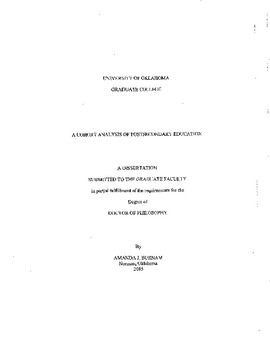| dc.contributor.advisor | Beutel, Ann | |
| dc.contributor.author | Burnam, Amanda J. | |
| dc.date.accessioned | 2015-05-21T15:19:08Z | |
| dc.date.available | 2015-05-21T15:19:08Z | |
| dc.date.issued | 2015-05-08 | |
| dc.identifier.uri | https://hdl.handle.net/11244/14636 | |
| dc.description.abstract | This study looks at factors that predict whether young people apply to and attend a postsecondary institution, and if they do attend, what level (two-year or less vs. four-year) and type (public vs. private) of postsecondary institution they first attend. Three different perspectives are used: family social capital, intersectionality, and the life course. Panel data for the sophomore cohorts of High School and Beyond (HS&B) and the Education Longitudinal Study (ELS) are used. The data are analyzed with logistic regression and multinominal logistic regression models. The results support the family social capital perspective (e.g., parental education and family structure were significant in almost every single model). There was some support for intersectionality (e.g., there were some differences in the effects for Asian men vs. Asian women and African American men vs. African American women, relative to white women. Support for the life course perspective was limited to cohort differences in the effects of mother’s aspirations, respondent’s educational expectations, and GPA quartiles. | en_US |
| dc.language | en_US | en_US |
| dc.subject | Postsecondary Education Cohort | en_US |
| dc.title | A Cohort Analysis of Postsecondary Education | en_US |
| dc.contributor.committeeMember | Bass, Loretta | |
| dc.contributor.committeeMember | Woodham Burge, Stephanie | |
| dc.contributor.committeeMember | Peck, B. Mitchell | |
| dc.contributor.committeeMember | Anderson, Kermyt G. | |
| dc.date.manuscript | 2015 | |
| dc.thesis.degree | Dr.P.H | en_US |
| ou.group | College of Arts and Sciences::Department of Sociology | en_US |
| shareok.nativefileaccess | restricted | en_US |
